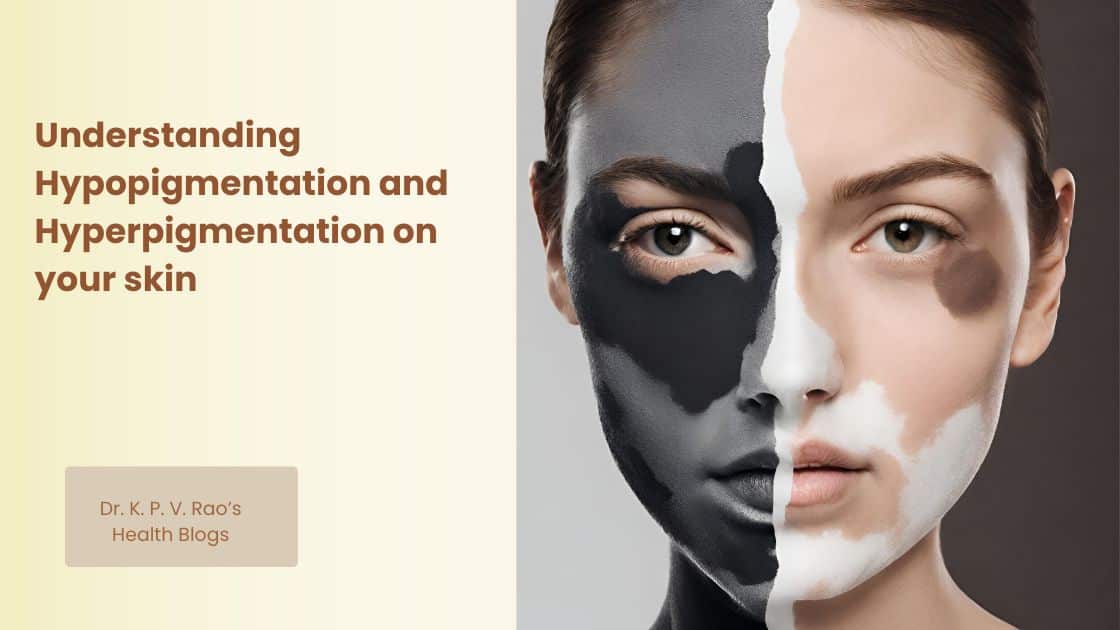Exploring the Causes and Solutions for Skin Patchiness
In my clinic, I frequently encounter patients with blemishes on their skin that are either hypopigmentation or hyperpigmentation conditions.
Hypopigmentation refers to a loss of skin pigmentation, resulting in lighter patches or areas on the skin.
On the other hand, hyperpigmentation involves an excess of pigment, leading to darker spots or patches.
Listen to this article
In some people with fair complexion it can appear as freckles [as shown in the pic below.]
To address these conditions, I employ various treatment approaches, including topical creams, chemical peels, etc.

In some cases where the condition is quite severe, I refer them to a dermatologist for laser therapy, and microneedling, tailored to each patient’s specific needs and skin type.
By offering personalized care and utilizing advanced techniques, I strive to help my patients achieve a more balanced and even skin tone.
In this article we learn what these two conditions are their signs symptoms and the management of some of these commonly found conditions.
Why do we develop either hyperpigmentation or hypopigmentation?
There are several reasons why people may develop dark or white patches on their skin. Some of the common causes of white patches on the skin include skin conditions, infections, autoimmune disorders, and exposure to certain chemicals.
One of the most common causes of white patches is vitiligo, a condition where the immune system attacks and destroys the melanocytes, which are the cells that produce pigment in the skin.
Another skin condition that can cause white patches is tinea versicolor, a fungal infection that affects the skin’s pigmentation.
Certain autoimmune disorders, such as lupus and scleroderma, can also cause white patches on the skin. We will learn about these two skin conditions in subsequent articles in future.
Exposure to certain chemicals, such as hydroquinone and phenol, can also cause depigmentation of the skin.
On the other hand, dark patches on the skin can be caused by a variety of factors, including
- sun exposure,
- hormonal changes,
- skin conditions such as melasma and
- post-inflammatory hyperpigmentation.
Melasma is a common skin condition that causes brown or gray-brown patches on the face, most of the times leaving a butterfly-like impression in between the two cheeks, while post-inflammatory hyperpigmentation is a condition that occurs after an injury or inflammation to the skin.
Causes of Hypopigmentation of Skin
Hypopigmentation, commonly referred to as white patches of the skin, can be caused by various factors. One of the primary causes is vitiligo, a long-term skin condition characterized by patches of the skin losing their pigment.
This occurs when the melanocytes, the cells responsible for producing melanin (a pigment that gives color to our skin), are attacked and destroyed by the body’s immune system.
Vitiligo can be triggered by
- stress,
- genetic predisposition, or
- exposure to certain chemicals.
Another cause of white patches is tinea versicolor, a common fungal infection that affects the skin’s pigmentation. This condition is caused by an overgrowth of yeast on the skin, which can lead to the development of white or light-colored patches.
Tinea versicolor is often more noticeable in individuals with darker skin tones due to the contrast in pigmentation.
Additionally, certain autoimmune disorders, such as lupus and scleroderma, can also lead to white patches on the skin.
These conditions can affect the skin’s pigmentation by disrupting the normal function of melanocytes, resulting in the development of white patches on the skin.
Vitiligo: Signs, Symptoms, Prevention, and Treatment
Vitiligo is a chronic skin condition characterized by the development of white patches on the skin due to the loss of pigment-producing cells.
The signs and symptoms of vitiligo include the gradual onset of white patches on the skin, typically starting on the hands, feet, face, and around body openings.

These patches may spread over time, and hair in the affected areas may also turn white.
Preventing vitiligo can be challenging, as the exact cause of the condition is not fully understood.
However, individuals with vitiligo are advised to protect their skin from sun exposure by using sunscreen and wearing protective clothing.
We’ll learn more about vitiligo in a subsequent article.
In some cases, surgical procedures such as skin grafting may be recommended to restore pigment to the affected areas.
Causes of Hyperpigmentation of Skin
Hyperpigmentation, commonly referred to as dark or black patches of the skin, can be caused by a variety of factors, including sun exposure, hormonal changes, and skin conditions such as melasma and post-inflammatory dark patches.
Exposure to the sun’s ultraviolet (UV) rays can stimulate the production of melanin in the skin, leading to the development of dark patches.
Hormonal changes, such as those occurring during pregnancy or as a result of hormonal therapy, can also contribute to black patches on the skin. It is mostly found on the face like a butterfly shaped patch, called Melasma, or stretch marks on the abdomen appearing during pregnancy and after delivery.
Melasma, also known as chloasma, is a common skin condition characterized by the development of brown or gray-brown patches on the face.

This condition is often associated with hormonal changes, particularly during pregnancy or with the use of oral contraceptives.
Melasma can also be triggered by sun exposure and is more common in individuals with darker skin tones.
Post-inflammatory hyperpigmentation is another common cause of dark patches on the skin.
This condition occurs as a result of injury or inflammation to the skin, such as acne, eczema, or a cut.
The skin responds by producing an excess amount of melanin, leading to the development of dark patches in the affected areas.
Another prominent cause of hyperpigmentation is type 2 diabetes. In type 2 diabetes, due to insulin resistance, where there is a insulin spill over due to excess insulin in the blood.
This causes changes in the skin, especially in folds like axilla, neck, groins,etc., causing brownish to blackish patches. This is one of a diagnostic features of type 2 diabetes and is called achantosis nigrans.
Hyperpigmentation: Causes, Signs, Symptoms, Prevention, and Treatment
Hyperpigmentation is a common skin condition characterized by the development of dark patches on the skin.
The signs and symptoms of hyperpigmentation include the appearance of brown, gray-brown, or black patches on the skin, particularly on the face, hands, and other sun-exposed areas.
Another type of hyperpigmentaion is dark circles around eyes.

You can read all about it here:
Dark circles around eyes (Doc) by K P Vasudeva RaoThese patches may vary in size and can be a source of cosmetic concern for many individuals.
Preventing hyperpigmentation involves protecting the skin from excessive sun exposure, as UV rays can stimulate the production of melanin and worsen existing dark patches.
Using sunscreen with a high SPF, wearing protective clothing, and seeking shade during peak sun hours can help prevent the development of dark or black patches.
Treatment options for hyperpigmentation include topical creams containing ingredients such as hydroquinone, retinoids, and azelaic acid, as well as chemical peels, laser therapy, and microdermabrasion. Some of the creams having this combination of anti-pigmenting medicines available in India are:
- Prorac plus gel
- Synglo cream
Likewise, there are many creams available on Amazon Pharmacy. You can try a few after consultation with your doctor.

Here are some other topics on Skin diseases published by me earlier:
Disclosure
Some of the links in this article are affiliate links, meaning if anyone clicks on it and makes a purchase, I recieve a small commision without any extra cost to the purchaser of the product. Rest assured, the links I have shared show quality products that I have used personally.
Conclusion
Understanding the causes and treatments for hypopigmentation and hyperpigmentation is crucial for individuals seeking to manage these skin conditions.
Whether dealing with the loss of pigment in vitiligo or the development of dark patches in hyperpigmentation, it is essential to seek professional medical advice to determine the most suitable treatment options.
By taking preventative measures, such as protecting the skin from sun exposure and addressing underlying hormonal or autoimmune factors, individuals can work towards maintaining healthy and even-toned skin.
With ongoing research and advancements in dermatology, there is hope for effective treatments and improved quality of life for those affected by skin patchiness.
Final Words
My next article will be on Vitiligo and how some celebrities with this condition have coped up with it.
Hope you have found this article interesting and useful. If yes, do share it on social media channels at the bottom of this post. You can also click to tweet here-
Understanding Hypopigmentation and Hyperpigmentation on your skin Share on XAdios.

